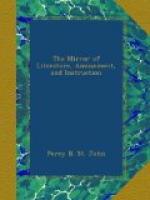THE MIRROR OF LITERATURE, AMUSEMENT, AND INSTRUCTION.
Vol. X, No. 289.] Saturday, December 22, 1827. [Price 2d.
Bushy Park.
[Illustration:] Among the suburban beauties of the metropolis, and as an attraction for home-tourists, Bushy is entitled to special notice, independent of its celebrity as the retreat of royalty—it being the residence of His Royal Highness the Duke of Clarence, an accurate portrait of whom will be presented, to our readers with the usual Supplementary Number at the close of the present volume of the mirror.
Bushy Park is an appendage to the palace and honour of Hampton Court; and though far from assimilating to that splendid pile, it is better fitted for rural enjoyment, whilst its contiguity to the metropolis almost gives it the character of rus in urbe.[1] The residence is a handsome structure, and its arrangement is altogether well calculated for the indulgence of royal hospitality—a characteristic of its present distinguished occupant, as well as of that glorious profession, to the summit of which his royal highness has recently been exalted. The park, too, is well stocked with deer, and its rangership is confided to the duke. The pleasure grounds are tastefully disposed, and their beauty improved by the judicious introduction of temples and other artificial embellishments, among which, a naval temple, containing a piece of the mast of the Victory, before which Nelson fell, and a bust of the noble admiral, has been consecrated to his memory by the royal duke, with devotional affection, and the best feelings of a warm heart.
[1] The Duke is a good economist of time; for what with excellent cattle and the glory of Macadamized roads, his R.H. comes to town in the morning, transacts his official business at the Admiralty, and frequently returns to Bushy to dinner.
The park is a thoroughfare, and the circumstances by which this public claim was established are worthy of record, as a specimen of the justice with which the rights of the community are upheld in this country. The village Hampden, in the present case, was one Timothy Bennet, of whom there is a fine print, which the neighbours, who are fond of a walk in Bushy Park, must regard with veneration. It has under it this inscription:—“Timothy Bennet; of Hampton Wick, in Middlesex, shoemaker, aged 75, 1752. This true Briton, (unwilling to leave the world worse than he found it,) by a vigorous application of the laws of his country in the cause of liberty, obtained a free passage through Bushy Park, which had many years been withheld from the public.” Regeneration (or the renewal of souls) is, however, a shoemaker’s forte.
The above engraving of Bushy is copied from an elegant coloured view, drawn by Ziegler, and published by Griffiths, of Wellington-street, Strand.




